
- Opaline Art Glass
- Age
- Brand
- Antique (22)
- Archimede Seguso (21)
- Artglass (39)
- Baccarat (62)
- Carlo Moretti (22)
- Cenedese (13)
- Empoli (14)
- Etling (15)
- Fenton (748)
- Fratelli Toso (19)
- Harrach (23)
- John Ditchfield (14)
- Kralik (28)
- Lalique (98)
- Moser (27)
- Murano (100)
- Rene Lalique (16)
- Sabino (98)
- Unknown (113)
- Unmarked (256)
- Other (1221)
- Maker
- Material
- Art Glass (12)
- Brass (8)
- Brass, Glass (9)
- Bronze (5)
- Chrome (11)
- Chrome And Glass (3)
- Chrome, Glass (9)
- Copper, Glass (3)
- Crystal (7)
- Crystal, Glass (10)
- Glas (3)
- Glass (2120)
- Glass / Cut Glass (25)
- Glass, Metal (7)
- Glass, Opaline (7)
- Opalescent Glass (10)
- Opaline (15)
- Opaline Glass (9)
- Opaline Milk Glass (4)
- Uranium Glass (4)
- Other (688)
- Type
- Type Of Glass
- Art Glass (7)
- Blown Glass (16)
- Blue Opaline (2)
- Carnival (10)
- Cranberry (64)
- Cranberry Opalescent (10)
- Crystal (29)
- Elegant Glass (8)
- Fenton Glass (2)
- Hand Blown Glass (33)
- Hobnail Opalescent (3)
- Milk Glass (4)
- Opalescent (16)
- Opalescent Glass (433)
- Opalescent Satin (2)
- Opaline (388)
- Pressed Glass (11)
- Uranium (19)
- Vaseline (4)
- Vaseline / Pearline (9)
- Other (1899)
Early 20th Century Art Deco Opalescent Glass Bacchantes Vase by René Lalique
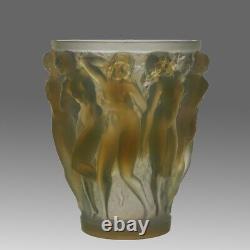

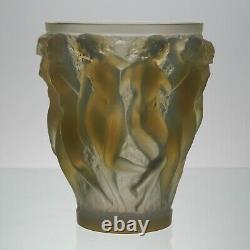
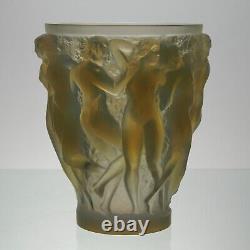
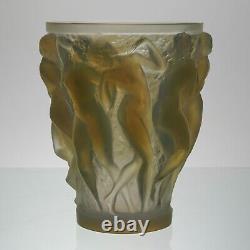
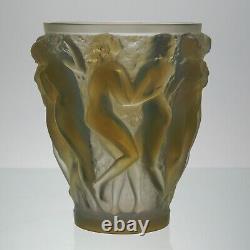
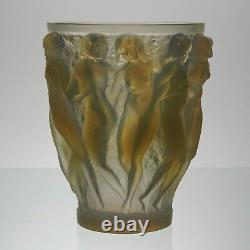
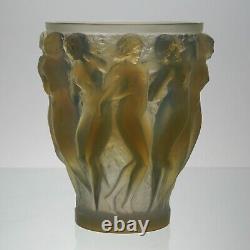
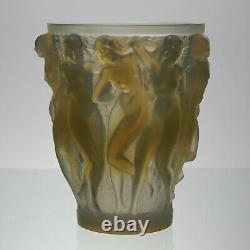
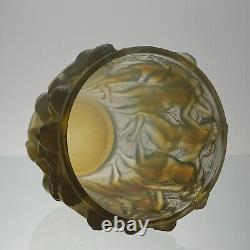
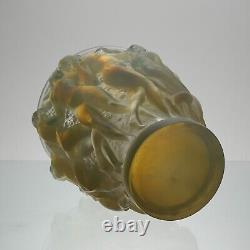
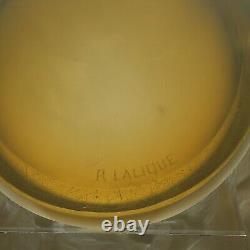


A superb René Lalique original Art Deco glass vase decorated with dancing bacchantes in various poses and pairings around the full circumference of the vase, exhibiting an excellent mix of frosted and opalescent glass with fine hand finished detail, signed R Lalique France. Signature identification: Under base R. Date introduced: July 22, 1927.
Felix Marchilac Catalogue Raisonné Page 438. The Bacchantes vaseis an exquisite representation of Art Nouveau brilliance. Crafted in 1927, this iconic vase s howcases Lalique's unrivaled talent in the realm of glass artistry.The design features a sensual and intricate relief of young maenads, or Bacchantes, draped in flowing vines and leaves. Their ecstatic dance seems to come alive, beautifully capturing the essence of ancient Greek mythology and the celebration of hedonistic pleasure. Lalique's innovative use of opalescent glass adds an ethereal glow, enhancing the vase's captivating allure. The play of light on the glass surface creates a mesmerizing ambiance, evoking a sense of mystery and enchantment. Throughout history, the Bacchantes vase has become a symbol of Lalique's unparalleled artistic vision and craftsmanship, garnering admiration from art connoisseurs worldwide.
Its timeless elegance and rich symbolism continue to inspire generations, solidifying René Lalique's legacy as a true pioneer in the world of decorative arts. Lalique - Catalogue Raisonné by Felix Marcilhac. In 1885, he opened his own workshop on Place Gaillon in Paris, the former workshop of Jules Destape.In 1887, Lalique opened a business on Rue du Quatre-Septembre, and registered the "RL" mark the following year. In 1890, he opened a shop in the Opera District of Paris. Within a decade, Lalique was amongst the best-known Parisian jewellers. Oiseau de Feu (Firebird), 1922.
In 1905, Lalique opened a new shop at Place Vendôme which exhibited not only jewellery, but glass works as well. It was close to the shop of renowned perfumer François Coty; in 1907, Lalique began producing ornate perfume bottles for Coty. The production of glass objects began at his country villa in 1902, and continued there until at least 1912.
In December 1912, Lalique hosted an exhibition of Lalique Glass-as his glass would come to be known-at the Place Vendôme shop. During the First World War, the glassworks produced mundane items in support of the war effort. In 1919, work began on a new production facility in Wingen-sur-Moder, which opened in 1921.
During the 1920s and 1930s, Lalique was amongst the world's most renowned glassmakers. René Lalique died in 1945. His son Marc Lalique took over the business, operating initially as M. Lalique" and later as "Cristal Lalique.
Under Marc's leadership, the company transitioned from producing its famous Lalique Glass to producing lead glass, commonly known as crystal. Marie-Claude Lalique took control of the company following Marc's death in 1977. Since 2010, Cristal Lalique has been wholly owned by Art & Fragrance. Established in 1936, Hickmet Fine Arts is an international family run business and one of the world's most important dealers in original Art Deco and Art Nouveau Antique Sculpture and Art Glass.
We are located at Gallery 85 on London's famous Portobello Road where we offer a fine range of sculpture, glass and works of art from the 19th and 20th Centuries by the most famous sculptors and artists from this period.

